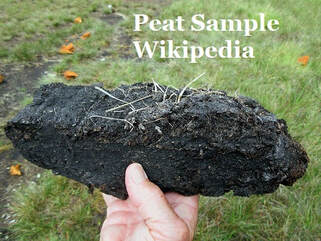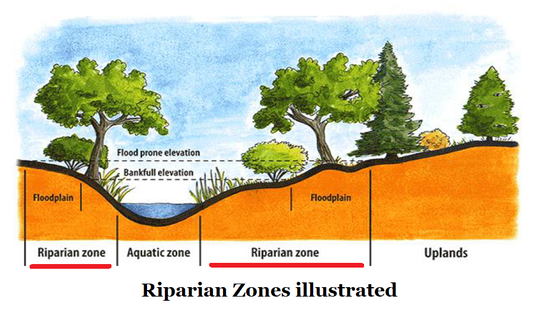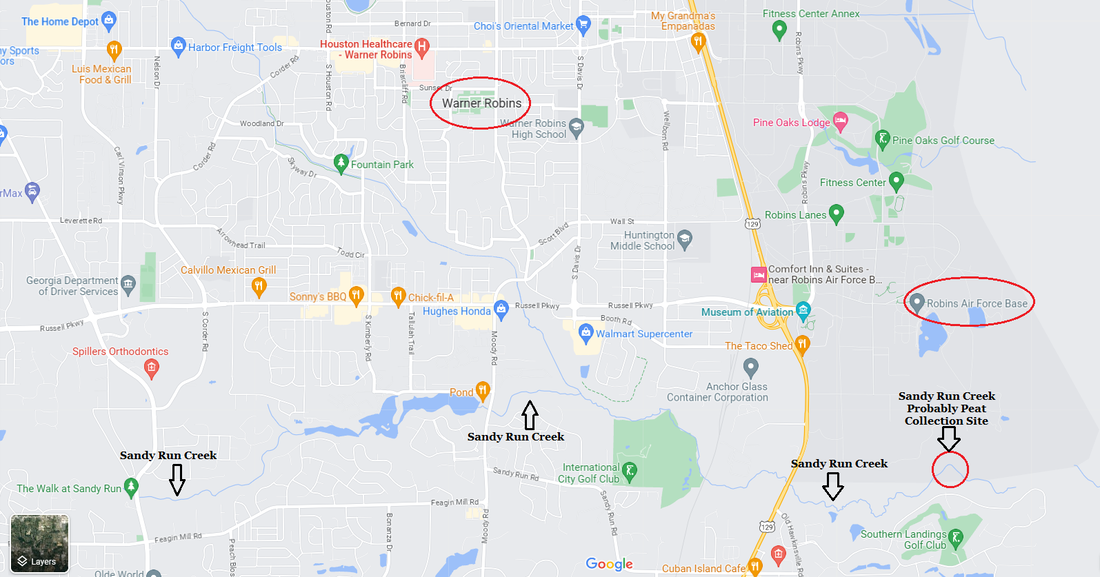20L; Sandy Run Creek Core,
Warner Robins
Houston County, Georgia
Northern Coastal Plain Environment
30,000 to 4,500 years ago
A Report Review By
Thomas Thurman
Posted 29/April/2023
Climates change frequently, in both long term and short-term increments.
There is ample evidence that mammoths, cave bears, and American cheetahs walked Georgia, long before people, and they very likely drank the waters of Sandy Run Creek.
In September of 2005 Heidi K LaMoreaux, George A. Brook & John A Knox published a report in Science Direct on a peat core sample, 5.4 meter deep, sample taken at a site of Sandy Run Creek on the south end of Robins Air Force Base, about 32 km (20 miles) south of Macon, GA.
There is ample evidence that mammoths, cave bears, and American cheetahs walked Georgia, long before people, and they very likely drank the waters of Sandy Run Creek.
In September of 2005 Heidi K LaMoreaux, George A. Brook & John A Knox published a report in Science Direct on a peat core sample, 5.4 meter deep, sample taken at a site of Sandy Run Creek on the south end of Robins Air Force Base, about 32 km (20 miles) south of Macon, GA.
|
Peat
According to Wikipedia peat is an accumulation of partially decayed vegetation or organic matter. It takes thousands of years for peatlands to develop the deposits. Peat forms when plant material does not fully decay in acidic and anaerobic conditions. It is composed mainly of wetland vegetation: principally bog plants including mosses, sedges, and shrubs. As it accumulates, the peat holds water. This slowly creates wetter conditions that allow the area of wetland to expand. |
|
Science in Support of Georgia
This research was funded by the National Science Foundation. Sandy Run Creek is a tributary of the Ocmulgee River. It flows from the west to the east, emptying in the Ocmulgee. The paper gives the Sandy Run core site as Latitude; N32° 34’40” Longitude; W83°5’00”; 80M asl However, this appears to be a mistake as those co-ordinates are for a location on Dry Run Creek about 15 miles east-southeast of Robins Air Force Base. The obvious explanation for this is an error in record keeping as there were cores taken from multiple locations and streams. |
LaMoreaux, and her team, reported that the peat core shows…
30,000+ years ago
30,000+ years ago
- The location was a swale (natural wet depression like a ditch) with a sandy floor flanked by low ridges of 1 or 2 meters high, a braided stream pattern was preserved and evidence of a low water table.
- Braided streams suggest flooding events.
What the core showed
30,000 to 25,000 years ago
30,000 to 25,000 years ago
- the climate was cool and dry with open grasslands and stands of pine & spruce.
- a warmer, wetter climate caused Sandy Run Creek to meander and cut some previous fill sediments, resulting in 13,000 year old material to be deposited directly on top of 25,000 year old material.
- Increased groundwater levels allowed vertical accumulation of plant matter and peat in local shallow depressions of the local valley.
- The cold Younger Dryas Event related pollens (12,900 to 11,700 years ago) indicates a cool, moist environment of open oak woodlands, mesic trees, riparian plant populations of alder and reduced levels of pine.
- Mesic tree species grow on well-drained, reasonably fertile soils. “Mesic” refers to the middle area in a moisture spectrum from dry (xeric) to wet (hydric).
- Riparian refers to plants growing waterside, stream side in this case.
11,650 to 6,000 years ago
- The Holocene Epoch began 11,650 years ago.
- Humans are unquestionably present in Georgia.
- Early to mid Holocene sees local forest dominated by tupelo and oak trees, indicating a wetter environment, pine trees are in the minority.
- White sand stringers and peat record periodic heavy rains, an elevated waters table and intervals of substantial run off.
- Other research shows that Georgia knew interglacial monsoons and extensive flooding and braided of waterways.
- A drier and more variable climate
- An increased rate of wildfires is indicated
- Southern pines replaced tupelo and oak.
- The absence of sand stringers in peat indicates fewer intense rainfall events.
|
The Younger Dryas Event
The Younger Dryas Event was a sudden return to glacial conditions during a long interglacial, or warm climate. It occurred from 12,900 to 11,700 years ago. It is one for three such events named for the wildflower Dryas octopetala, a small evergreen subshrub which forms large colonies and proliferates during colder climates. The cold shift was relatively sudden, taking place over a few decades/ Temperatures fell by 4 to 10 °C (7.2 to 18 °F). This shows that climates can shift quickly, either colling or warming. |
Globally
For comparison & context
In 2009 Dale Russell with the North Carolina Museum of Natural Sciences stood as lead author on a paper suggesting that the Southeast might have been a warm refuge during the worst of the glacial events. Fred Rich from Georgia Southern University was part of Russell's team. Below is a timeline of significant events from that paper.
For comparison & context
In 2009 Dale Russell with the North Carolina Museum of Natural Sciences stood as lead author on a paper suggesting that the Southeast might have been a warm refuge during the worst of the glacial events. Fred Rich from Georgia Southern University was part of Russell's team. Below is a timeline of significant events from that paper.
- 2,700,00 Onset of significant Northern Hemisphere glaciation
- 1,350,000 years ago Mammoths (Mammuthus) appear in North America; about 40 glacial cycles ago.
- 210,000 to 160,000 years ago sees the first appearance of the genus Bison south of 55 degrees North in North America; about 2 glacial cycles ago. (Added by author: At about 200,000 years ago our species emerged.
- 130,000 years ago the Illinoian glacial interval ends, Sangamonian interglacial interval begins. (Glacial retreat)
- 118,000 years ago the Wisconsinan glacial interval begins (Glacial advance)
- 23,000 to 19,000 years ago was the last Last Glacial Maximum
- 19,000 years ago saw an abrupt 10 meter rise in sea levels due to glacial melting.
- 14,500 years ago saw the beginning of the Bølling-Allerød abrupt warming, onset of rapid glacial retreat, (sea levels quickly rose by more than 100 meters or 328 feet.)
- 13,400 years ago Clovis hunters unquestionably present in North America
- 12,800 years ago Younger Dryas cooling event abruptly begins.
- 12,750 years ago extinction of megafauna essentially complete in mid-latitude North America.
- 12,000 years ago the Beringian isthmus flooded. (This is the Bering Sea land bridge between Alaska and Asia; now flooded it prevents further pedestrian access to North America from Asia)
- 11,570 years ago the Younger Dryas cooling abruptly ends. Wisconsinan glacial interval ends.
Animals of a different time
No vertebrate fossils were found by the researchers, that's not what they were looking for, but Georgia has a rich history of vertebrates during these periods. Going back to 30,000 years ago most of the modern species are present, but also confirmed in our fossil record are mammoths, mastodons, horses, giant beaver, giant sloths, giant armadillos, cave bears, American cheetahs, grey wolves... the list is long. (See Section 20B; Pleistocene Epoch Vertebrate List of this website)
No vertebrate fossils were found by the researchers, that's not what they were looking for, but Georgia has a rich history of vertebrates during these periods. Going back to 30,000 years ago most of the modern species are present, but also confirmed in our fossil record are mammoths, mastodons, horses, giant beaver, giant sloths, giant armadillos, cave bears, American cheetahs, grey wolves... the list is long. (See Section 20B; Pleistocene Epoch Vertebrate List of this website)
You undoubtedly ask yourself, how do we know all of this?
In the case of Sandy Run Creek peat beds LaMoreaux, and her team took and studied a core sample. After documenting the stratigraphy, color, and sediment texture the core was x-ray photographed in 25cm (9.8”) increments at the UGA Veterinary School. (Thanks, UGA.) Mineral samples appear while on an x-ray, peat appears black. Loss of ignition, charcoal analysis, radiocarbon dating, direct observation of pollen, and other methods were employed.
There were no sediments dating between 25,000 to 13,000 which suggests they were eroded, cut away, by stream incision related to a regional change from braided to meandering stream patterns at 16,000 to 11,000 years ago. An increase in sediment load can shift a stream from braided to meandering.
In the case of Sandy Run Creek peat beds LaMoreaux, and her team took and studied a core sample. After documenting the stratigraphy, color, and sediment texture the core was x-ray photographed in 25cm (9.8”) increments at the UGA Veterinary School. (Thanks, UGA.) Mineral samples appear while on an x-ray, peat appears black. Loss of ignition, charcoal analysis, radiocarbon dating, direct observation of pollen, and other methods were employed.
There were no sediments dating between 25,000 to 13,000 which suggests they were eroded, cut away, by stream incision related to a regional change from braided to meandering stream patterns at 16,000 to 11,000 years ago. An increase in sediment load can shift a stream from braided to meandering.

Between 25,000 and 13,000 there is a fundamental shift in sediments. At 25,000 years and older the sediments are primarily sandy with minor peat. The younger sediments, 13,000 years ago and less, are mainly peats.
Research shows that the Late Pleistocene environment for Houston County (Sandy Run Creek), from 30,000 to 25,000 years ago both colder and drier than now. (Bear in mind that this research is 14 years old and our local, modern climate has warmed further.) The Late Pleistocene vegetation was open grasses, stands of pine (likely northern pine) and a few spruce trees. Fire activity was minimal. During much of this a windier climate is indicated as sand dunes from braided water channels were reworked by winds. (See Section 20C; Georgia’s Eolian Dunes of this website.)
Large paleo-meanders along the Ogeechee River in east Georgia dating between 10,000 and 4,500 years ago indicate at least a doubling of the present discharge, a 10% to 30% increase in precipitation and pronounced precipitation seasonality. That means dry season and rainy season, probably monsoons.
Research shows that the Late Pleistocene environment for Houston County (Sandy Run Creek), from 30,000 to 25,000 years ago both colder and drier than now. (Bear in mind that this research is 14 years old and our local, modern climate has warmed further.) The Late Pleistocene vegetation was open grasses, stands of pine (likely northern pine) and a few spruce trees. Fire activity was minimal. During much of this a windier climate is indicated as sand dunes from braided water channels were reworked by winds. (See Section 20C; Georgia’s Eolian Dunes of this website.)
Large paleo-meanders along the Ogeechee River in east Georgia dating between 10,000 and 4,500 years ago indicate at least a doubling of the present discharge, a 10% to 30% increase in precipitation and pronounced precipitation seasonality. That means dry season and rainy season, probably monsoons.
None of this should surprise us, in 1974 Michael Voorhies reported similarly aged fossil from Wilkes County, Georgia and several were from species only known from boreal (cold) climates. (See the website Section 20I; Pleistocene Vertebrate Fossils on Georgia's Piedmont.)
In 2009 a team led by Dale Russell reported many cold weather species from the southeastern fossil record, including reindeer (caribou), in a large review of the area's changing climate during the Pleistocene Epoch. They also shared reports on warm weather fossils far north of where they are found today, such as giant tortoise and alligator fossils in NW Georgia caves. (See this website's Section 20F: A Southeastern Thermal Enclave, Glacial Ice and the Sunny South.)
In 2009 a team led by Dale Russell reported many cold weather species from the southeastern fossil record, including reindeer (caribou), in a large review of the area's changing climate during the Pleistocene Epoch. They also shared reports on warm weather fossils far north of where they are found today, such as giant tortoise and alligator fossils in NW Georgia caves. (See this website's Section 20F: A Southeastern Thermal Enclave, Glacial Ice and the Sunny South.)
A dune building episode would mean the sands were already in place from river floor and braiding, the sands were relatively dry, and the since eolian dunes are only found on the east bank of rivers, the winds were steadily and consistently blowing from west to east.
Houston County, like the rest of Georgia, has seen great fluctuations in her climate in the last 30,000 years.
Similar research should be pursued over a wider area of Georgia and funded by the State of Georgia.
Houston County, like the rest of Georgia, has seen great fluctuations in her climate in the last 30,000 years.
Similar research should be pursued over a wider area of Georgia and funded by the State of Georgia.
References:
- LaMaoreaux, Heidi K.; Brook, George A.; Knox; Late Pleistocene And Holocene Environments of the Southeastern United States from the Stratigraphy and Pollen Content of a Peat Deposit on the Georgia Coastal Plain; Paleogeography, Paleoclimatelology, Paleoecology, Science Direct; Vol.280, issue 3-4, pages 300-312; 15/Sept/2009
- Russell, Dale A,; Rich, Frederick J; Schnieder, Vincent; Lynch-Stieglitz, Jean; A Warm Thermal Enclave in the Late Pleistocene of the South-eastern United States. Biological Review, Vol.84, Pgs. 173-202, 2009









